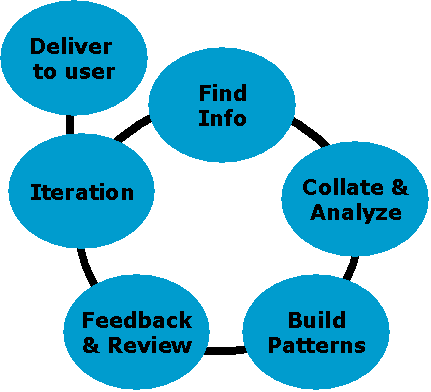Based on a user-needs assessment, information is collated and analyzed to build patterns. The iterative process is repeated by incorporating feedback and review it until it matches the needs of the user.
Find Information
Where is information available? Who has it? How will it be used?
In this first stage we prepare to find information by learning about user and target audience - who are they, what are their activities, what kind of decisions they take, what information they need for the decisions, etc.
We then look at sources of information, and the quality and quantity of information that matches the needs of the user. It will also be necessary to look at the timeliness and trustworthiness of information necessary.
It is critical to remember that the information needs of the user may change over time and at different stages of the decision-making process.
Collate and Analyze
How can we match user needs with information available?
Information collected is matched with users' needs by identifying the strengths, weakness, opportunities and threats (commonly called the SWOT analysis methodology).
In this stage, the information is analyzed for the relative advantages it offers, the action it enables, the improvements can be implemented, the opportunities made available, and the obstacles faced.
At this stage, information is only comprehended and categorized for later use. This analysis is essentially non-judgmental and seeks to understand the context where the information is to be used.
Build Patterns
What are the interlinakages between the different pieces of information?
This is where the interlinkages between the different categories and pieces of informantion is identified. There are always problems-behind-problems (that is, a 'visible' problem that is actaully caused by another 'invisible' problem), and there are solutions-for-solutions (that is - solutions that lead to more solutions). The collected information should illustrate and relate to such problems and solutions.
The patterns of interlinkages between the different pieces of information highlight such cause-effect relationships. Flowcharts, framework and outlines are created to illustrate these relationships, and identify key points / themes that need to be emphasized.
Pertinent information is hen used to flesh out the outline.
Feedback and Review
What enhancements can be envisaged to the info patterns?
A focus group created out of the end-users is created to review the information patterns created in the previous stage. This is important to make sure that the information collated meets the needs of the users.
It also enables channels of information flow to be created to ensure that timely and current information is delivered to the user continuously.
The focus group provides feedback and suggestions for improvement so that the cycle can be improved further.
Iteration
The information design cycle may be repeated several times iteratively, based on the feedback and review obtained from the focus group, until it meets the users needed requirements.
This is indeed a continual process where new information and changing needs of the user require further analyses and pattern building. This is done in close consultation with the focus group, or directly with the end-users themselves.
Delivery to User
How is the information actually delivered to the user?
The delivery of information to the user should be done carefully - at the right time, to the right user, at the right time and at the right level of governance.
This is critical to ensure that the right decisions are ultimately taken and implimented.
Ultimately, the information cycle illustrated above is an aid to decision-making, of understanding what and how information is used by the target users, and developing a channel to deliver it to the user.
It should make the 'a-ha' - a spark of insight and inspiration - happen for the user so that the right decision can be taken at the right level at the right time.

 Hari Srinivas - hsrinivas@gdrc.org
Hari Srinivas - hsrinivas@gdrc.org